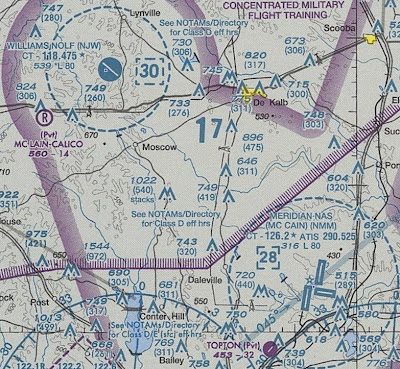AOPA had big (and good) news today with this announcement that
a bill proposing to eliminate the third class medical requirement for many types of common flying has been introduced in the House of Representatives. What does this mean, and why did it happen?
What is in the bill?
The bill itself is so short that I've included it at the bottom of this post. In short(er), it will allow pilots to fly aircraft with 6 seats or less on noncommercial flights in good weather conditions below 14,000 feet without having to have any medical certificate besides a driver's license. In effect, it renders the third class medical obsolete for the majority of small aircraft pilots.
The bill is short because it's just being introduced. It's not even close to being law at this point; this is just the first step. The final legislation, once it goes through the gears of Congress, will likely look much different. Nonetheless, this is an excellent start at getting rid of an extremely outdated and ineffective requirement.
What is a third class medical?
There are three kinds of medical certificate, cleverly named the First, Second, and Third class. The medical requirements are rather stringent for a first, somewhat less demanding for a second, and the third is very similar to a routine physical you might already be getting from your doctor.
Who does this affect?
Airline pilots require a first class, smaller commercial operations (some charters, dropping skydivers, aerial photography, and other miscellaneous for-hire flying activities) require a second class, and everyone else currently needs a third class medical.
This bill won't affect airline/commercial operators at all. The only change it will make will be for the "everyone else" category. If this bill does pass, you will no longer need to have an FAA medical to hop in a 172 and fly a half an hour away to get a $100 hamburger.
Does this mean you can fly with just a driver's license?
No, you still need a pilot's license to fly. You just wouldn't need both a pilot's license AND a medical certificate if you're flying small airplanes noncommercially.
What if I've been taking/going to take flying lessons?
This means that you won't need to see a doctor to get your license, but you'll still need to go to your local FAA office and get a student pilot's certificate. As it is right now, the student pilot certificate is commonly combined with the medical certificate, so you can get both at once. Sport pilot students have been getting their student pilot certificate from the FAA office (or a Designated Pilot Examiner) ever since the Sport Pilot certificate was created.
What if I give flying lessons?
Flight instruction has always been in an odd no-man's land between commercial and non-commercial flying. It's a rare thing that you can take money for, but not be considered "for hire". If you're giving instruction to someone who already is a pilot, you don't even need a medical right now. This would probably extend that no not needing one at all, but I wouldn't exactly count on that. The FAA will probably issue a letter of interpretation once the process is done. In short, if the FAA keeps the attitude they have now, you won't need a medical at all any more to give primary instruction.
Can I still get a third class medical?
Sure you can, if you want to spend the time and money for some reason. You just wouldn't
have to unless you fly IFR, you have a pressurized aircraft that you fly higher than 14,000 feet, etc.
How does this affect safety?
For a decade, there has been a whole category of pilots who do not need an FAA medical: the Sport Pilot. Sport pilots are limited to two-seat aircraft, can only fly during the day below 10,000 feet, and have a few other restrictions. The years since this category of certificate was created have given us time to collect data as to the effectiveness of the third class medical.
Now that the data is in, the results are clear: there have been exactly ZERO accidents due to medical factors in sport pilots. That's right: not a single one. That is doubly impressive considering the majority of people flying light sport aircraft are older pilots who decided not to renew their medical. That means that the "highest risk" group has turned out to be an imaginary risk.
The idea of having one group of individuals need medical certification to do something similar to what one group can do without certification isn't new. In fact, you do it every day! You can hop in your car and drive on the freeway all day with nothing more than a driver's license. However, each semi that you pass is driven by someone who had to pass a medical. Getting rid of some of the third class medical requirements makes aviation more closely align with driving, which is something almost everyone has experience with and causes no one any worry.
Does this mean there would be no medical requirements at all?
Far from it. It means that the requirements would be more efficient. As it stands now, all that is required for a third class medical is a basic checkup from an FAA-approved doctor who may not (and probably won't) see you again for 2-5 years. That's not much more stringent than the medical requirements to renew a driver's license every 4 years (in Ohio; your state may be different). Since your driver's license is your medical certificate to fly, if your driver's license is suspended for any reason (such as drunk driving), your flying privileges are, too.
Even under the current system, before every flight, pilots are self-certifying that they are in proper condition to fly. This will not change. If you develop a condition that would affect your physical ability to fly safely, or you're taking medication that would affect it (like strong cold medicine, painkillers, etc.), you're not legal to fly
with or without a medical certificate.
If you get into an accident due to a medical factor (remember: this hasn't happened at all with the Sport Pilot category), it will still be your fault, just as it is today. This bill would make that even
more clear, because you won't even have the excuse "I just got a medical certificate last year and I was fine then!" to try to fall back on. One suggestion that AOPA made when petitioning the FAA to make this change years ago was to require an annual (I'd prefer biennial) online class about how you can determine your fitness to fly. I'd support that, and I'd roll it into the biennial flight review requirements to make it simple.
Why did this bill get introduced?
AOPA and
EAA, the two major grassroots aviation organizations, have been trying to get the FAA to extend sport-like privileges to private pilots flying small aircraft for several years. The FAA has passive-aggressively been stalling and claiming lack of data ever since. It has been becoming clearer and clearer that the FAA is unwilling to make any move without a cattle prod. This bill is that cattle prod, and considering that this bill goes
way past the small changes the alphabet groups were asking for, it's a pretty high-voltage prod at that.
I'm no beltway insider, but I wouldn't be surprised if the reason the bill goes far past what they were asking for is so that when it gets negotiated down, the end result will be effectively sport pilot privileges. Asking for more gives the FAA room to save face by narrowing it to just that while giving AOPA/EAA/Joe Pilot what they really wanted anyway. The secret to good negotiation is letting everyone be able to get up from the table feeling like their side won, and this bill gives ample room for that.
The proposed bill:
A BILL
To direct the Administrator of the Federal Aviation Administration to issue or revise regulations with respect to the medical certification of certain small aircraft pilots, and for other purposes.
Be it enacted by the Senate and House of Representatives of the United States of America in Congress assembled,
SECTION 1. SHORT TITLE.
This Act may be cited as the ‘‘General Aviation Pilot Protection Act of 2013’’.
SEC. 2. MEDICAL CERTIFICATION OF CERTAIN SMALL AIRCRAFT PILOTS.
(a) IN GENERAL.—Not later than 180 days after the date of enactment of this Act, the Administrator of the Federal Aviation Administration shall issue or revise medical certification regulations to ensure that an individual may operate as pilot in command of a covered aircraft without regard to any medical certification or proof of health requirement otherwise applicable under Federal law if—
(1) the individual possesses a valid State driver’s license and complies with any medical requirement associated with that license;
(2) the individual is transporting not more than 5 passengers;
(3) the individual is operating under visual flight rules; and
(4) the relevant flight, including each portion thereof, is not carried out—
(A) for compensation, including that no passenger or property on the flight is being carried for compensation;
(B) at an altitude that is more than 14,000 feet above mean sea level;
(C) outside the United States, unless authorized by the country in which the flight is conducted; or
(D) at a speed exceeding 250 knots.
(b) COVERED AIRCRAFT DEFINED.—In this section, the term "covered aircraft" means an aircraft that—
(1) is not authorized under Federal law to carry more than 6 occupants; and
(2) has a maximum certificated takeoff weight of not more than 6000 pounds.
SEC. 3. REPORT.
Not later than 5 years after the date of enactment of this Act, the Administrator of the Federal Aviation Administration shall submit to Congress a report that describes the impact that the regulations issued or revised under section 2 have had, including statistics with respect to changes in small aircraft activity and safety incidents.


























